
|   |

|   |
 e-mail: leelakaverivenkat@gmail.com Odishi Raga Utsav April 22, 2019 Held at Delhi's Triveni auditorium, with the finest of floral decorations, arrangements and a plethora of courtesies extended to each of the participants by the organizers of the event - Odishi Academy of Gopal Panda - the title of the Utsav almost forced the question out of me, "So what's changed with all your efforts?" Ever since I can remember, Odishi music has been fighting for a place in the firmament of classical styles. The great Jayadeva from Odisha in his 12th century kavya Gita Govinda mentions ragas like Gundakeri, Varadi, Desavaradi, Mangalagujjari and the 15th century Oriya Mahabharata written by Sarala Das of Odisha mentions modes like Bhairavi, Malasri, Garri, Bhairava, Vasanta, and even talas like Khemta are mentioned. "All these and ragas like Sree and Prathamamanjari are part of our Odishi music system," claims Pandit Gopal Chandra Panda who has been at the forefront of the movement for Odishi music to recapture its old glory and bring back into circulation its old ragas. Apart from training under his brother Guru Damodar Chandra, Gopal Chandra Panda studied Hindustani sangeet under Pandit Kundal Adi Narayana and Pandit Govind Chandra Paluskar. After years of training under these gurus, he returned to Odisha to study Odishi music in the Guru/shishya tradition under Pandit Singhari Shyam Sunder Kar. Gopal Chandra Panda's argument is simple. Referring to the leading kavyas like Vaideshi-Vilas by Upendra Bhanja, Rasakallola by Dinakrishna, Kishor-Chandranana Champu by Samanta Sinhara, Mathuramangala by Bhaktacharan Dasa where ragas and talas are specifically mentioned, he quotes whole passages from texts like Gitaprakash, Sangeeta Narayana, Sangeeta Muktavali (said to be closest to Odishi music by scholars) which, apart from several other modes refer in detail to Deshi and Khambavati (specially mentioned in Gitaprakash) that these are ragas special to Odishi music where even the prayog and svara patterns match with practice. So in typical fashion, this Utsav had a start with the Gita Govind ashtapadi "Pralaya prayodhijale..." in raga Malawa and it was sung by Prof. Mitali Chinara who was the master of ceremonies for the event. 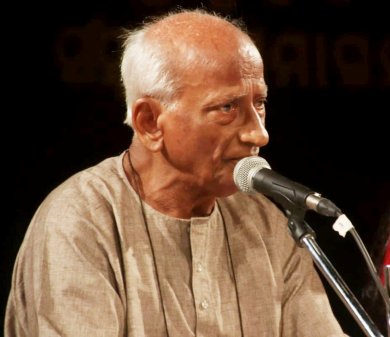 Guru Gopal Panda 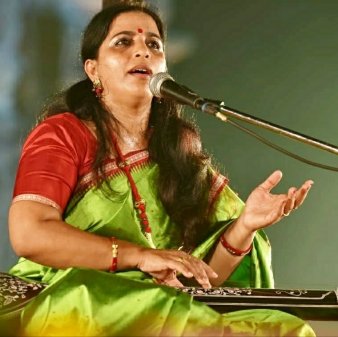 Sangita Panda The concluding part on the first day of the festival, was with Odissi dance rendered by Madhavi Mudgal and her disciples. The Pallavi composed by Gopal Chandra Panda in Gundakri in Jati taal, an old raga, with dance composition by Madhavi Mudgal, was rendered by her disciples. The distribution of the 14 matra taal and the clean, absolutely uniform technique and well held bodies of the students showed what good teaching can achieve. The abhinaya depiction by Madhavi Mudgal in a solo form, was built round the lyric "Kohibaku Lajja" in Rasamanjari, again an old raga for Odishi, mentioned in the Sangeeta Muktavali written by Harichandran belonging to the royal family of Kanika (placed round 1590 by Pandit Banambra Acharya who brought out an edited version in 1955) and Sangeeta Narayana (1718-1769). Madhavi was accompanied by vocal support from Kuntala Bhowmick, Jeetendra Kumar on mardala, Yaar Mohammad on sitar, and Gandhi Mallick wielding the manjira. The nayika in this composition while expressing shyness, still wants to tell her sakhi how she, despite her initial diffidence, was overcome by Krishna's romantic advances (rati rachai). The dancer, with underplayed expressions, slim as a wand, in her costuming aesthetic was, as usual, flawless.  Odishi Raga Utsav 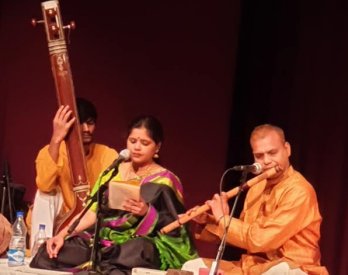 Sudha Raghuraman Sarita Panda, the younger daughter of Guru Gopal Panda, trained in Odishi music and dance, and now pursuing music seriously, in the typical vintage style prescribed by her father, performed on the second evening, with Niranjan Sahu on mardala. Despite struggling against a sore throat, she gamely carried on, presenting two compositions in Chinta Kamodi, another original raga. In the Kamodi anga are several ragas, but not this which is not found in other musical texts and is mentioned in Sarla Das' Mahabharata, "Onago sakhi kishobha paochi Shyama" in Jati tala of 14 beats. She wove improvisations within the lines of the composition. In the second "Chaha Goluti" in Ektali, she wove in solfa passages improvising on the spot. Odishi Brunda Gayan by Guru Gopal Panda's Odishi Academy, for this critic was one of the most enjoyable parts of the two day fare. With senior disciples from the Academy combining with commendable unison, the composition in Punnagavarali mentioned in Sangeeta Parijata was in tala Jhampa of ten beats and the next composition was in Ektali of four beats. Incidentally Carnatic music has Punnagavarali but is not the same. In "Shyam murati kori," the elaborations woven round each line, the set solfa passages, and the tiny on the spot solo improvisations, were sung with excellent understanding and visible enjoyment by all the participants of the group. To bring down the curtain was Odissi abhinaya by Jyoti Shrivastava and her students. She had worked with Sangita Panda who in consultation with Guru Gopal Panda had composed the ragavilasini - each of the moods expressing a situation in sringar based on an old raga. The start was with Khambavati raga, "Shyamo lagi sajani" set to Jati tala, where the lovelorn nayika, ecstatic whenever she sees Krishna, tries to garland Shyamo who plays hide and seek - there one moment and not there the next. The next part in Gaud raga shows veera sringara, where the jilted nayika though disappointed seeing Krishna romancing with others, is mentally strong, "sakhi najani mu hori galiti." Expressing more anger than a broken heart, there is a fleeting scene in the narrative when the gopis bathing and having fun in the water, have their clothes hidden away by Krishna. The flute and violin music intervention makes them forget their bare-bodied state and they pay homage to Krishna, getting back the garments. 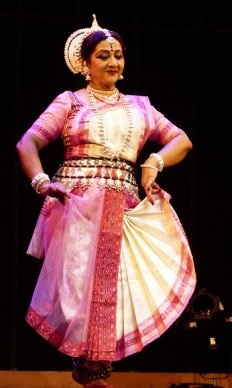 Jyoti Shrivastava ; Photo: Avinash Pasricha 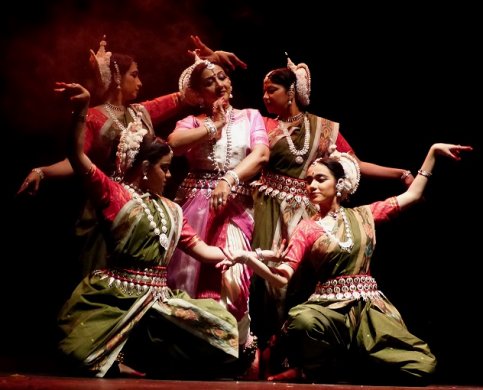 Jyoti Shrivastava and group ; Photo: Avinash Pasricha The concluding bit in Shanta sringar was in raga Desakhya set to ektali. "Lekha thilaki yeha karomego" says the nayika accepting that this was her destiny. The recording was with Sangita's vocal, Agnimitra Behera on violin, Abhiram Nanda on flute and Sachhidananda Das who contributed the rhythmic part on mardala. Voice production and sound were good but the recording seemed to hit a block every now and then with the music stopping for half a second. Jyoti Srivastava has always been a sensitive dancer where abhinaya is concerned. While her part was convincing, what she has composed for the students will have to be worked on a little more. Sushant Maharana as Krishna combined well with Jyoti. While I am all awe and praise for the kind of effort that Guru Gopal Panda is putting in, ultimately it is not a limited group, but a whole lot of vocalists singing and putting in their creative imagination into the elaboration of the ragas that one may gather from the texts, which will give the necessary conviction to his work. As a very important part of history, it has to establish its worth through practice and rendition. Again referring to the texts, taking pentatonic ragas like Mallara and Gandhara, going by their definitions in Sangeeta Narayana, when the Jati singing pattern would omit both Sa and Pa, which is unthinkable today when they form the fixed universal tonic for every raga. Graha was the name of the tonic and amsha was the name for the dominant note. By the 16th century, it is said that barring some cases in Odisha, this system was no longer in vogue. And I cannot understand how ragas mentioned in Jayadeva's work can be re-established for the system of music used was different in those days, so what one deems as the position of a note can be only a matter of interpretation - which all scholars and singers may feel differently about. Which is why perhaps, scholars working on musical treatises in Odisha, do not always agree and till ragas are recognized as such by the larger practicing section, how do they get established as a part of the entire tradition?  Writing on the dance scene for the last forty years, Leela Venkataraman's incisive comments on performances of all dance forms, participation in dance discussions both in India and abroad, and as a regular contributor to Hindu Friday Review, journals like Sruti and Nartanam, makes her voice respected for its balanced critiquing. She is the author of several books like Indian Classical dance: Tradition in Transition, Classical Dance in India and Indian Classical dance: The Renaissance and Beyond. Post your comments Please provide your name and email id when you use the Anonymous profile in the blog to post a comment. All appropriate comments posted with name & email id in the blog will also be featured in the site. |